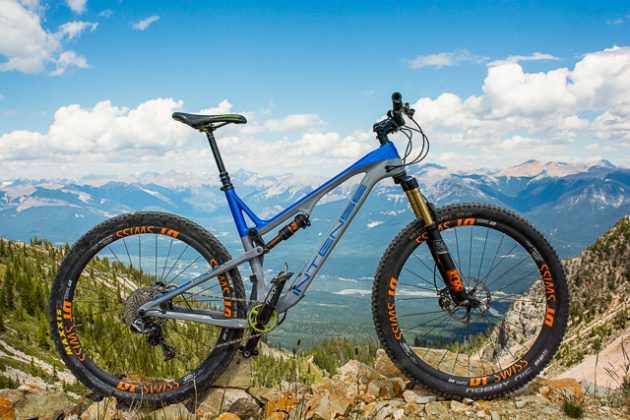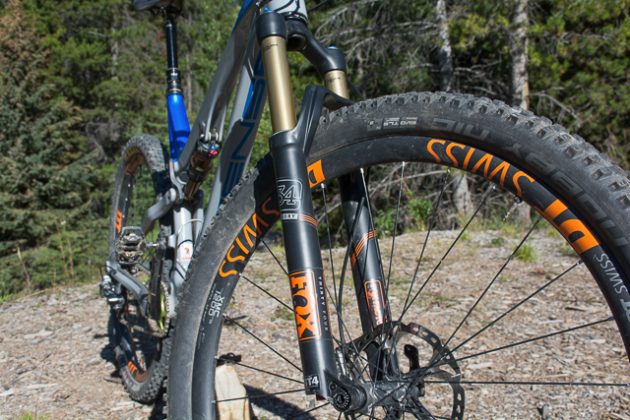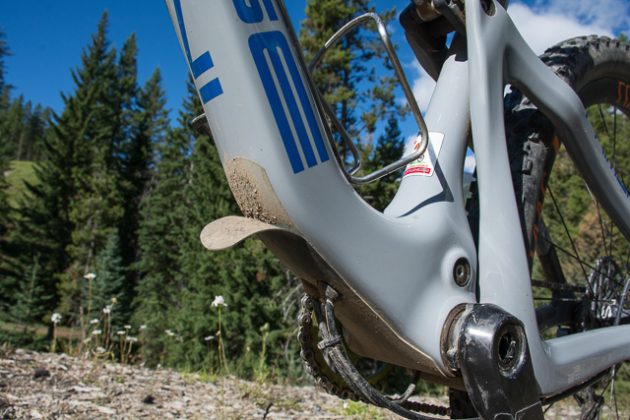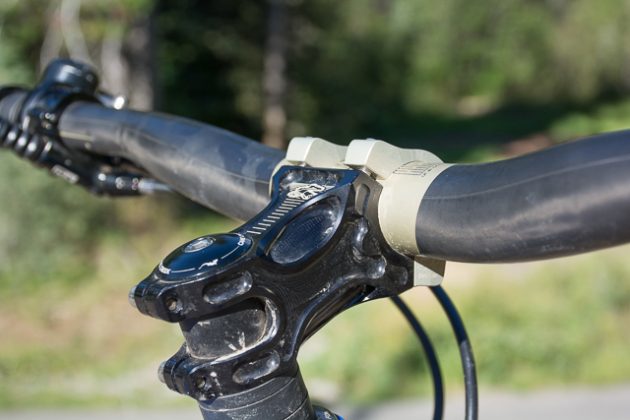Review: Intense Primer
Originally posted on August 16, 2016 at 12:49 pm
Tester: Zach White
Sizes Small, Medium, Large, XL(tested)
MSRP: $9499 Factory build, $6999 Pro build, $5899 Expert build
Weight 25.9lbs, as tested
The Bike
Intense’s all new Primer will be quite familiar to Spider 29 fans, as it’s essentially a nicely updated version of the already well-sorted Intense Spider of last year. Sticking with a VPP chassis featuring travel adjustable between 115 mm and 130 mm (without geometry variation), the Primer’s biggest difference from last year’s Spider is a refinement in the linkage. The recent expiration of VPP’s patent has allowed Intense, along with other manufacturers, to put their own spin on the design. This first restriction-free version, however, looks quite similar to the improvements made by Santa Cruz’s models where the lower linkage has been tucked up and out of harm’s way, while decreasing chain stay length at the same time.

The Primer comes in both standard and SL carbon options, both of which have a higher modulus from last year’s frames, allowing for larger mandrels inside the tubes for improved consistency in the carbon walls, ultimately equating to stronger and lighter frames. Also improving upon the strength and stiffness are larger-diameter bearings on both versions of the Primer, and the SL loses a few grams by way of a carbon upper link and titanium hardware.

Other improvements to the new Primer include Boost spacing front and rear, a 1-degree slacker 67.5-degree head tube angle, a quarter-inch shorter 17.25-inch chain stays, and a noticeably steeper 75-degree(effective) seat tube angle. Standover height drops about an inch on average throughout the sizes to allow more room for 125 mm drop dropper posts(all models will come stock with Reverb Stealth 125’s), and reach is stretched to varying lengths throughout the sizes to allow for shorter stems.
The Ride
Over a few week test period, our size XL Primer loaner was ridden and raced in a handful of different regions and disciplines including the 6-day Singletrack 6 and Sun Valley Enduro Cup, and overall it was a pleasure to throw a leg over during its short stay. Just like the Spider 29 of last year, it’s initial impression is that of an XC oriented suspension tune and build, but with a few pieces added to the spec to keep it from getting pigeonholed with some of the less playful options out there. However, it didn’t take long to realize that its 130 mm of travel couldn’t be used as an excuse to not occasionally drop into steep, techy and chunky chutes, or huck off a BC feature or three. Granted, it’d be the wrong tool of choice for an audience focused on said trails and features, but it showed a surprisingly versatile personality while traveling through new-to-me trail systems and wanting to get a taste of every flavor offered.

Both front and rear triangles felt stiff and efficient enough for a bike of this genre, but did show a bit of flex under harsher riding with a 200-lbs. pilot. Smaller riders on frames smaller than XL, as well as less aggressive trail riders on any size Primer will probably be perfectly happy on it, but don’t expect it to ride like an Intense M16, either.
Though Primer’s JS Tune(named after Jeff Steber, founder of Intense) suspension is unabashedly XC, it was a bit of a surprise to keep wanting to switch the rear shock up to the middle damping setting for conditions that warranted regular pedaling or were smooth enough to want to pump everything. It wasn’t a pig by any means in the open damping position, but did seem to squat down a little bit, and squished more than what’s expected of a VPP design when pedaling was more than a spin or from off the saddle. Once in that middle damping setting, the bike pedaled quite nicely and efficiently, and still absorbed rough trail pretty well, too. And only on long road approaches and ascents did the damping get flipped up to position 3, along with adjusting the 3-position fork damper accordingly as well.

On the rougher trail end of the spectrum, it wouldn’t have been my first guess that the Primer was set to its full 130 mm of travel, as the somewhat progressive stroke felt a bit shy of that. The bike did very well in small to medium hits, and never seemed to harshly bottom out on bigger hits, but would get a little overwhelmed in places like long rock garden sections taken at higher speed, even with the rebound damping wide open. Swapping the shock bolt’s position to the 115 mm travel mode added to this feeling of being both more progressive and more suggestive of a chassis with a hair less suspension than claimed, so the review bike was quickly reset to 130 mm mode. This isn’t to say the Primer is under-gunned in its class by any means, as it continued to surprise and impress in how well it handled itself in conditions outside of expectations for a 5-inch travel 29er, but it was by no means gobbling up anything and everything thrown at it like a bike with more travel would, either.
It was a pleasure to go from another brand’s 130mm travel 29er that had a relatively low bottom bracket to the Primer with its 13.25-inch height. Not only did it lighten up the front end a little bit and allow the front end to get up and over trail features more easily, but striking pedals on rocks and roots wasn’t nearly as big of an issue, either.

That same slightly higher bottom bracket also may have made the 67.5-degree head tube feel slightly less slack than it sounded like it’d handle on paper. It wasn’t a bad thing, but again, without looking at geometry numbers until first impressions were made, the guess on Primer’s front angle would’ve been about a degree steeper. Regardless, the Primer handled itself very nicely in tight switchback climbs and through technical sections that were biased to shorter wheelbases, even though this XL Primer was as big of a wheelbase as it’s available in. The only time the geometry felt a little less than ideal was through steep and deep sections of trail, and in looser, faster turns where the safety net of a slacker head tube angle wasn’t available to rely on. Overall, though, it was a nice compromise of handling better in the lump sum of what this bike is designed to shine at, and still managed reasonably well just outside its comfort zone.
The Build
Our particular review bike was a mix of the most expensive Factory build kit and slightly lower Pro build – mostly by way of not having SRAM Eagle available, and being the blue and grey color way specific to the Pro build. A couple of minor gripes were that the new Race Face Next cranks didn’t offer much shoe/ankle clearance, and that Intense spec’d an XC style bike with a rear axle that requires two steps and two different sized allen keys to remove the rear wheel.

A collet-style rear axle is designed to keep things clean, light and stiff, but also made me miss a QR style version when working on the bike – especially out on the trail. A 5 mm allen key is used to remove a tapered bolt that screws into the axle, and then a 6 mm allen key is needed to remove the axle. It’s not brain surgery, but just seems like an overly complicated and awkward system.
A couple of personal adjustments to the Primer’s spec were swapping out the stock 30-tooth front ring with a 28-tooth ring for a 6-day XC stage race, and switching to a saddle more specific to my, um, curves. Otherwise, everything else was ridden stock and seemed a good fit for Intense’s intentions of the Primer.

Time on the Primer left a great impression, and it’ll be hard to box it up and send it home to Intense. Coming from a rider with more of an enduro/gravity bias, it’d be a great bike to have in the quiver for less technical rides, and for those random assignments where I find myself pretending to be an XC racer. The Primer is efficient and light, but there’s no denying that it’s an Intense, either, which makes it a pleasantly playful trail bike option, too. As a one-bike quiver, it’d be an excellent choice that handles an impressive scale of terrain, though its spec and general svelte carbon frame would probably suggest a stouter option if trail appetite leaned more towards relentless pounding.